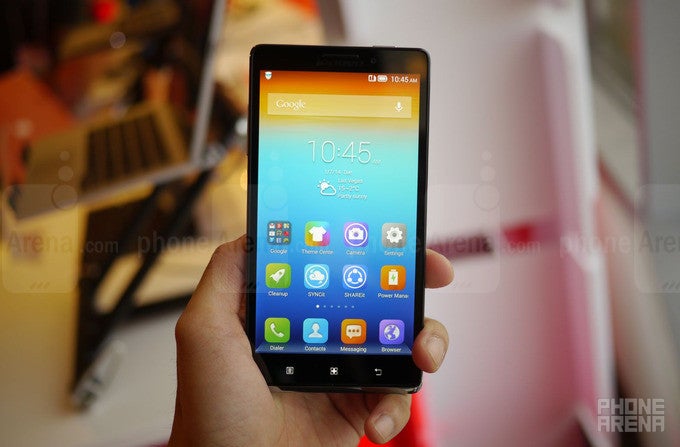Lenovo Vibe Z hands-on

The Lenovo Vibe Z is one of the higher-end smartphones that the Chinese company has on display at CES. And it is a respectable contender indeed – a good-looking and powerful device sprinkled with some 150Mbps 4G LTE goodness on top. But with a price tag of $550, how much of a following will it manage to accumulate? Let's check it out in detail.
Design
The Lenovo Vibe Z is a phone that feels... somehow different in the hand. Its back plate has been treated to a fine texture that feels like fabric when touched even though it is just "laser-etched polycarbonate", as Lenovo describes it. It attracts no fingerprints and it should be more resistant to scratching than ordinary plastic. All in all, the phone is rather large, yet surprisingly slim. Also, the moment we grabbed it we noticed how light it was for its size. Like it or not, the Lenovo Vibe Z has a sealed body construction so its 3000mAh battery can't be accessed by the user. Something we aren't too happy with is that the power button is on top and slightly harder to reach than it should be. Unless you use your other hand to press it, that is.
Display
So here are all the raw numbers: on the front of the Lenovo Vibe Z we find a 5.5-inch IPS LCD display with a resolution of 1080 by 1920 pixels. As one might expect, graphics displayed on the panel look sharp and detailed thanks to this high pixel count. And even though a figure of 400ppi isn't record-shattering, it proves sufficient for a display of this size. At a glance, colors look good too and the viewing angles are also more than acceptable. A layer of Gorilla Glass 3 is protecting the display from scratches.
Interface
Lenovo is launching the Vibe Z with Android 4.3 on board, although one might not recognize Android's OS at first with all those UI modifications that the smartphone maker has implemented. One of the first tweaks we noticed was that the app drawer had been scrapped. Instead, all of the app icons are placed right there on the user's home screen. Another interesting change is the added theme center where one can personalize their Vibe Z from. You may apply themes throughout the whole UI, or just choose which segment of the interface to modify.
Processor and memory
As we mentioned above, the Lenovo Vibe Z is a high-end device with high-end hardware packed under its hood. A 2.2GHz quad-core Snapdragon 800 SoC is in use along with 2GB of RAM. Overall, the phone runs smoothly, although it doesn't feel right to judge its performance without testing it thoroughly. But at the same time, we doubt that it will have troubles handling any task with ease.
There are 16GB of storage available on the Vibe Z – not bad, although we wish we had the option for more. Sadly, there is no microSD card slot available on the phone so there's no way of expanding its storage.
Camera
Now here's something you don't see on a smartphone every day. The Lenovo Vibe Z has a 5-megapixel front-facing camera with a wide field of view for selfies of higher quality. Moreover, Lenovo has chosen to put a variety of filters and effects for improving your shots with little effort. For more serious shooting there's a 13MP auto-focus camera placed on the phone's back. It stands out with a very wide aperture of f1.8, which would theoretically improve low-light shots by letting more light hit the sensor. (Real-life results may vary, of course.) A dual-LED flash is present to help out when light is scarce.
Expectations
The Lenovo Vibe Z is shaping up as a pretty decent phone. Seriously, it seems like an offering worthy of attention even with its $550 price tag. As long as you're fine with its lack of expandable storage, that is. Too bad that we won't be seeing it in the United States anytime soon. The Lenovo Vibe Z is to arrive in Indonesia, Malaysia, Thailand, Saudi Arabia, United Arab Emirates and the Philippines in February, but a US launch is not in Lenovo's plans.











Things that are NOT allowed: